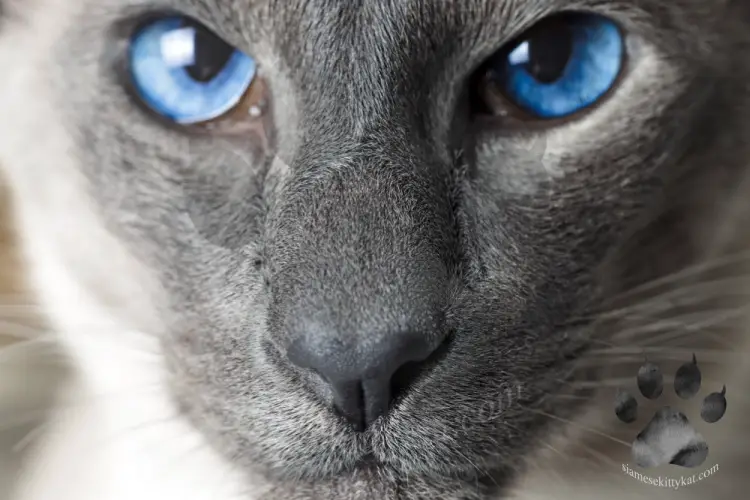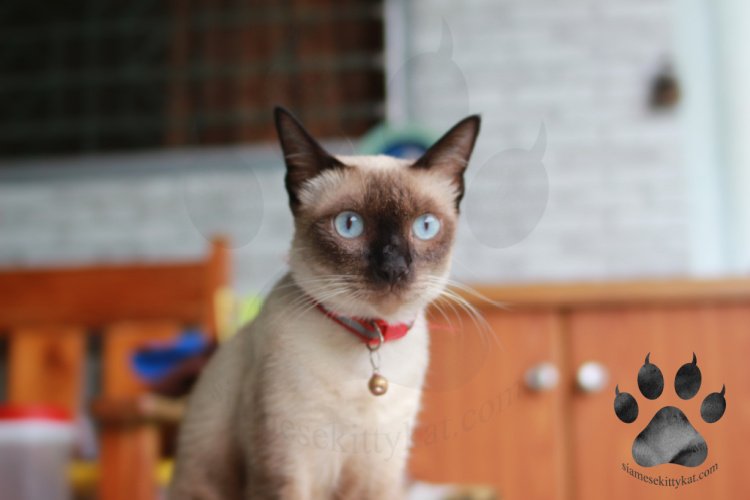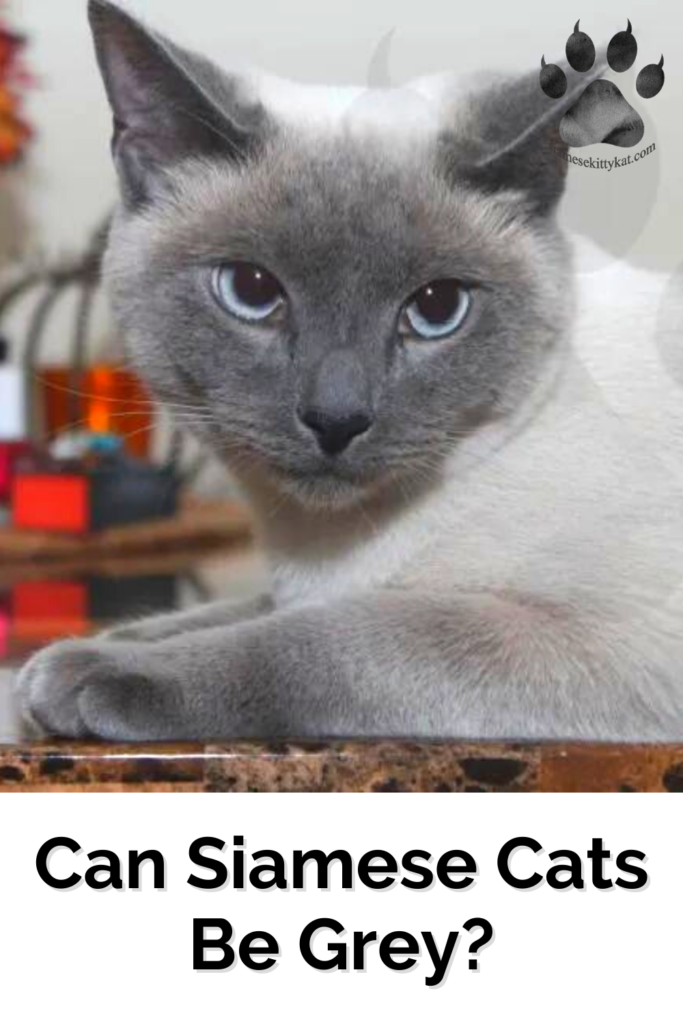Yes, Siamese cats can be grey! They can either develop some grey hairs during old age (yes, cats are not exempt from the good old greys), or their points may be grey due to their genetic makeup.
Points refer to the coldest parts of your Siamese’s body, and these include the nose, ears, tail, and paws of the Siamese. Their colors only develop in these specific places due to a genetic mutation that affects the enzymes that produce pigment.
For that reason, a Siamese can not be all grey. Whether they’re a lilac point, blue point, or chocolate point, no Siamese can be all one color. So, Siamese cats can be partly grey, but not all grey.
What is a gray Siamese cat called?
A Siamese with grey points is referred to as a lilac or frost point Siamese.
Lilac points are one of the four Siamese officially recognized. This also includes:
These pretty kitties sport an icy-white coat with pink undertones. They are the lightest of all Siamese cat colors, and have frosty pinkish-grey points, hence the name “frost point.” The lilac point’s nose leather and paw points are soft pink in color.
When the lilac point first appeared in the 50s, many experts dismissed them as a poorly bred blue point variation. It can be easy to see where the misunderstanding came into play, as the blue point and the lilac point do look somewhat similar.
Thankfully, these beautiful Siamese variations gained their rightful recognition in the US in 1955. I, for one, am very happy about this recognition; what a world it would be without the faithful lilac point!
Is it normal for Siamese cats to go grey?

Yes, it is quite common for Siamese cats to go grey. There are a few reasons for this.
- Old age
If your Siamese is getting old, you may have noticed a few grey hairs here and there.
It may be harder to notice a Siamese going grey due to old age because of their light coats. I once had a black moggie who developed quite a few grey spots, and they were very noticeable within their dark coat.
But, aging is the typical cause for a Siamese to turn grey.
- Sun bleaching
If your Siamese is often outside or bathing in the sun, their fur can become lighter. This could change the color of their fur from their natural color to somewhat grey.
This color change doesn’t affect the health of your Siamese, so don’t worry!
- Diet issues
If your Siamese isn’t on a healthy diet, this could affect the color of their fur. This will not change their fur color completely, as a lack of nutrition isn’t enough for that. It may, however, cause your Siamese to become grey much quicker.
Giving your Siamese a good and nutritious diet is the best way to ensure their fur stays nice and healthy!
- Temperature change
As I mentioned earlier, the color of a Siamese is controlled by a gene mutation. This mutation is actually altered by temperature, so their fur will also change if your Siamese gets a hotter or colder body temperature.
If they get hotter, you may find your Siamese’s coat to get lighter. If your Siamese is a lilac point Siamese, a colder body temperature can cause their points to become even more grey.
- No particular reason
Believe it or not, your Siamese might go grey for no reason! As your Siamese sheds their winter coat, you may notice a change of color within their fur, and this could simply mean that their fur was always meant to be grey.
What is the rarest Siamese cat color?

Out of all of the official color points Siamese, the lilac point is the rarest. They are quite hard to find, as they have been sparsely bred for quite a few years.
It will be very hard, if not impossible, to adopt a lilac point Siamese from a shelter. If you would like this specific color variation, you’ll most likely have to find a breeder (a reputable one at that!)
Is my Siamese cat blue or lilac?
It can be pretty difficult to distinguish between these two Siamese kitties as they are very similar in color. That being said, there are a few ways to tell them apart.
The main difference between the lilac point Siamese and the blue point Siamese is their fur, color points, paw color, and nose leather.
A lilac point Siamese has a creamy or frosty white body, with pinkish-grey color points. Their nose leathers and paw pads are a soft pink, with bright blue eyes. They are the lightest of all Siamese variations and will continue to be light throughout their lives.
The blue point Siamese has a more platinum-colored coat, with a slight grey tint towards it. Their points are a dark shade of blue-ish grey, and their bellies and chests are slightly lighter than the rest of their bodies.
Lilac point Siamese cats are often confused as a “diluted blue point,” but they are actually the diluted version of the chocolate point! Yes, this is also slightly confusing for me, as I would also think they are closer to the blue point than the chocolate, but it is what it is!
How do Siamese cats get their color?
Time to get your biology coat on as we’re going to get into some science!
Several different genes determine a cat’s coat, and modifier genes then determine those patterns. Siamese cats, however, have this special modifier gene that actually inhibits the pigments from developing (remember, the temperature gene we spoke about earlier?)
So, this modifier gene can only affect a Siamese in temperatures between 100 – 102.5 degrees. Once their body temperature drops below 100 degrees Fahrenheit, the fur color darkens as the pigment develops. Like humans, cats become the coldest on their feet, noses, ears, and tails (although we don’t have one of those.)
If you’ve ever seen a fresh batch of Siamese kittens, you’ll notice that most of them are born entirely white. Their markings, or points, will then develop a few weeks after birth.
This is because when the Siamese kitten is inside its mother’s womb, it is very warm and, in turn, blocks the color gene from developing. As their fur is exposed to the cooler temperatures of the outside world, only then will they begin to show their color.
It could take up to a year for a Siamese to fully develop their colors, and even then, their points will usually get darker with age.
When do Siamese cats stop changing color?
As I mentioned above, a Siamese will continue to change color throughout adulthood.
Once your cat has reached adulthood, their color changes won’t be very drastic. But, you can still expect your Siamese to look slightly different, especially when it comes to the thickness of their coat.
When your Siamese loses their winter coat in summer, they will look slightly lighter, especially if they are often bathing in the sun.
As your Siamese gets old, their coat will become duller and darker, and you may notice the flecks of grey I mentioned earlier.
It is perfectly normal for your Siamese to change color throughout their lives, so always be ready for a surprise!
Want to immerse yourself more in the captivating world of Siamese cats? I’ve got all the information you need from their distinct color points to their fun personalities: Siamese Cats: Unique Features and Personality
Get your FREE Siamese Cat 2024 Printable Calendar


